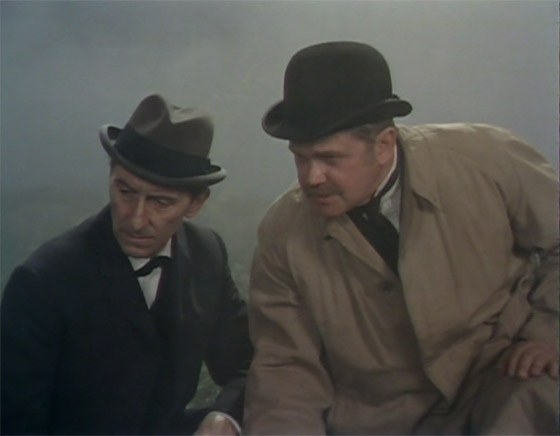 [In this new series, which will be categorized in the menu at left as LATE NIGHT TV, I’ll be looking at select episodes of either acclaimed or overlooked cult television series.]
[In this new series, which will be categorized in the menu at left as LATE NIGHT TV, I’ll be looking at select episodes of either acclaimed or overlooked cult television series.]
Earlier this week it was announced that Borders, which had previously declared bankruptcy, would be closing all of its remaining stores by September. I’ve always enjoyed browsing Borders or attending their author readings, but it’s a strange new world that I should be mourning the death of a big box store. In both high school and college I worked at independent bookstores, at least one of which has closed in the intervening years due to competition from Borders and Barnes & Noble. Now Borders has closed, partly due to Amazon’s cheaper prices. It’s become increasingly difficult to enjoy the simple pleasure of spending an evening browsing bookshelves and making happy discoveries of books and authors you never knew about before. Here in Madison, Wisconsin, we have a few independent bookstores that have weathered the storm, but most specialize in used books, a market which can thrive in a college town. Last weekend I was excited to discover that one indie bookstore, which I’d presumed had closed years ago, was still alive and kicking: Booked for Murder. Since the store specializes in mystery novels, and I don’t often read mysteries, I hadn’t ventured inside before; but on my first, belated visit I found myself spending a good deal of time exploring their shelves, discovering and purchasing some books I would never have thought to search for on Amazon. (For example, a compendium of two experimental novels by Alain Robbe-Grillet, which will hopefully inform my upcoming review of Last Year at Marienbad, the masterpiece for which he penned the screenplay.) Booked for Murder seems to be doing just fine, thank you. With a mix of new and used books, mystery-themed DVDs and board games, and some mood-setting music piped in through an antique radio – not to mention, of course, knowledgeable staff – the store is a perfect example of what an independent bookstore can offer that online shopping cannot. They even host monthly gatherings of different book clubs, such as a local society devoted to the stories of Agatha Christie, and another to Sherlock Holmes. And it was in the Holmes section of the store where I found A&E’s recently-released 3-DVD set The Sherlock Holmes Collection, starring Peter Cushing. Twenty dollars cheaper than Barnes & Noble, and a dollar more expensive than Amazon’s current price, in case you’re keeping track. But I didn’t bother to check at the time; I snatched it up and proudly took it home.
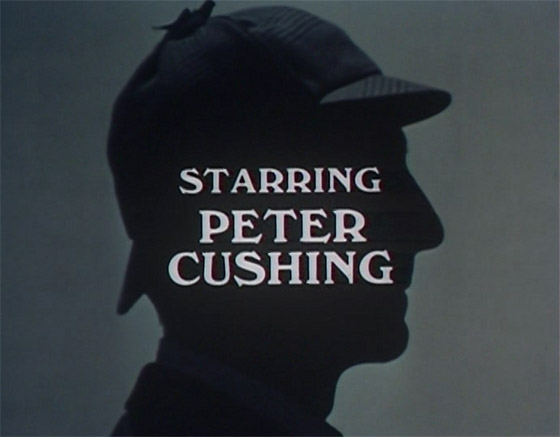 I’m a fan of Cushing, but have always particularly relished his portrayal of Holmes in 1958’s The Hound of the Baskervilles, made for Hammer Films. All right, his performance may have been just a bit too mannered, but he looked every bit the Strand illustrations of Holmes. It was perfect casting for a wonderful actor. That film remains one of my favorite Holmes adaptations – I’m a sucker, too, for the lush color and the token Hammer touches of blood and chills – but I didn’t know what to think when I saw that the first two episodes on the A&E set were a two-part adaptation of Doyle’s “Hound.” Cushing, doing “Hound”, again? On a BBC budget? I’d be forced to compare/contrast, though I was a tad reluctant. I wanted to see Cushing tackle the rest of the Holmes canon…alas, this and four other Holmes mysteries are the only surviving episodes of the sixteen-episode television series (properly titled Sir Arthur Conan Doyle’s Sherlock Holmes). So I’ll take what I can get.
I’m a fan of Cushing, but have always particularly relished his portrayal of Holmes in 1958’s The Hound of the Baskervilles, made for Hammer Films. All right, his performance may have been just a bit too mannered, but he looked every bit the Strand illustrations of Holmes. It was perfect casting for a wonderful actor. That film remains one of my favorite Holmes adaptations – I’m a sucker, too, for the lush color and the token Hammer touches of blood and chills – but I didn’t know what to think when I saw that the first two episodes on the A&E set were a two-part adaptation of Doyle’s “Hound.” Cushing, doing “Hound”, again? On a BBC budget? I’d be forced to compare/contrast, though I was a tad reluctant. I wanted to see Cushing tackle the rest of the Holmes canon…alas, this and four other Holmes mysteries are the only surviving episodes of the sixteen-episode television series (properly titled Sir Arthur Conan Doyle’s Sherlock Holmes). So I’ll take what I can get.
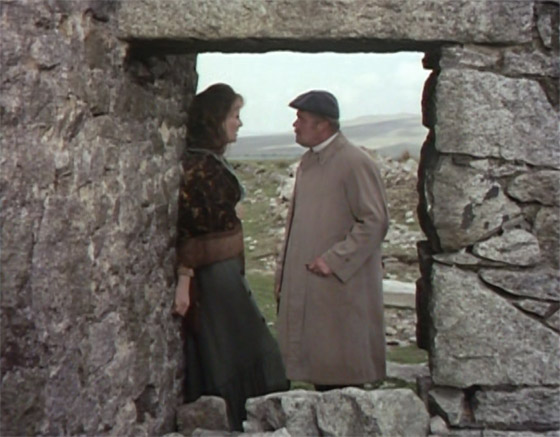 To parrot the tired old factoid, Sherlock Holmes has appeared in more films than any other fictional character, and “The Hound of the Baskervilles” has always been one of the most popular stories to adapt. It’s easy to see why, since the idea of Holmes facing off against a monster (of sorts) is an appealing one. But it also presents two very large problems. For one thing, when the titular hound finally appears, it’s a challenge to make it look like more than just a big old dog (and who doesn’t love dogs?). More critically, Holmes is only present for the beginning and ending of the story, with Watson left as the detective for the long stretch in-between. Now, if you’re reading the stories, neither of these presents much of a problem. To the first point: you have your imagination, and the dog can be as fearsome as you want it to be. To the second – if you’re reading the stories chronologically, it’s actually refreshing to see Watson as detective, and a bit nerve-wracking to see him do his level best without Holmes to guide him.
To parrot the tired old factoid, Sherlock Holmes has appeared in more films than any other fictional character, and “The Hound of the Baskervilles” has always been one of the most popular stories to adapt. It’s easy to see why, since the idea of Holmes facing off against a monster (of sorts) is an appealing one. But it also presents two very large problems. For one thing, when the titular hound finally appears, it’s a challenge to make it look like more than just a big old dog (and who doesn’t love dogs?). More critically, Holmes is only present for the beginning and ending of the story, with Watson left as the detective for the long stretch in-between. Now, if you’re reading the stories, neither of these presents much of a problem. To the first point: you have your imagination, and the dog can be as fearsome as you want it to be. To the second – if you’re reading the stories chronologically, it’s actually refreshing to see Watson as detective, and a bit nerve-wracking to see him do his level best without Holmes to guide him.
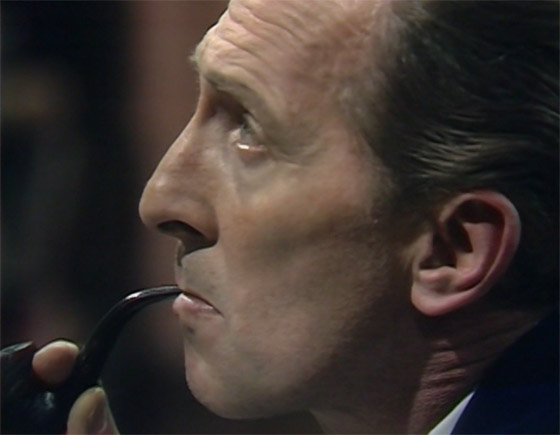 I suppose that’s part of the reason I was disappointed to see “Hound of the Baskervilles” as the first Holmes mystery in the set. I was a Cushing fan, and I wanted to see Cushing; I didn’t want him to drop out of the bulk of his own adventure…again. But this was not actually the first of the episodes to air (that would be “The Second Stain,” which is one of the lost episodes); and, in fact, I learn from Baker Street Dozen that this series was a continuation, of sorts, of an earlier Holmes series that ran from 1964-1965 (Douglas Wilmer played the detective). Still, “Hound” was a big deal for this new Sherlock Holmes run. A two-parter, with some location footage on the moors and a reportedly lavish (by BBC standards) budget, it’s not just an ambitious bit of 60’s British programming, but a revision to the previous Hammer classic, an attempt to really get the Doyle story done faithfully and right.
I suppose that’s part of the reason I was disappointed to see “Hound of the Baskervilles” as the first Holmes mystery in the set. I was a Cushing fan, and I wanted to see Cushing; I didn’t want him to drop out of the bulk of his own adventure…again. But this was not actually the first of the episodes to air (that would be “The Second Stain,” which is one of the lost episodes); and, in fact, I learn from Baker Street Dozen that this series was a continuation, of sorts, of an earlier Holmes series that ran from 1964-1965 (Douglas Wilmer played the detective). Still, “Hound” was a big deal for this new Sherlock Holmes run. A two-parter, with some location footage on the moors and a reportedly lavish (by BBC standards) budget, it’s not just an ambitious bit of 60’s British programming, but a revision to the previous Hammer classic, an attempt to really get the Doyle story done faithfully and right.
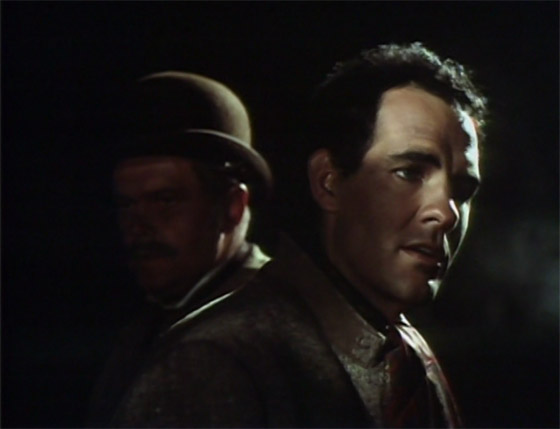 It is more faithful, and though with both episodes together the story runs only slightly longer than the 1958 Terence Fisher film, it does touch on more plot details from Doyle’s tale, and dispenses with the Hammer-isms (Sherlock doesn’t have to battle a tarantula, for example). Cushing, a decade older and slightly more gaunt, gives a very different performance. His Holmes is less kinetic, though still engaged; there’s a touch of world-weariness to him. He’s very good in the final scenes, when he suddenly realizes he’s made a grave mistake in his plans: he hasn’t taken the English fog into account, which threatens to foil everything. (My wife and I were both reminded of the 2010 Stephen Moffat series Sherlock, in which Holmes is ignorant that the Earth revolves around the Sun, because that information is useless to his work.) He’s also excellent at declaring “the game is afoot” as he charges out of the tavern; this, for an actor, must be like delivering “to be or not to be” while trying to sound spontaneous.
It is more faithful, and though with both episodes together the story runs only slightly longer than the 1958 Terence Fisher film, it does touch on more plot details from Doyle’s tale, and dispenses with the Hammer-isms (Sherlock doesn’t have to battle a tarantula, for example). Cushing, a decade older and slightly more gaunt, gives a very different performance. His Holmes is less kinetic, though still engaged; there’s a touch of world-weariness to him. He’s very good in the final scenes, when he suddenly realizes he’s made a grave mistake in his plans: he hasn’t taken the English fog into account, which threatens to foil everything. (My wife and I were both reminded of the 2010 Stephen Moffat series Sherlock, in which Holmes is ignorant that the Earth revolves around the Sun, because that information is useless to his work.) He’s also excellent at declaring “the game is afoot” as he charges out of the tavern; this, for an actor, must be like delivering “to be or not to be” while trying to sound spontaneous.
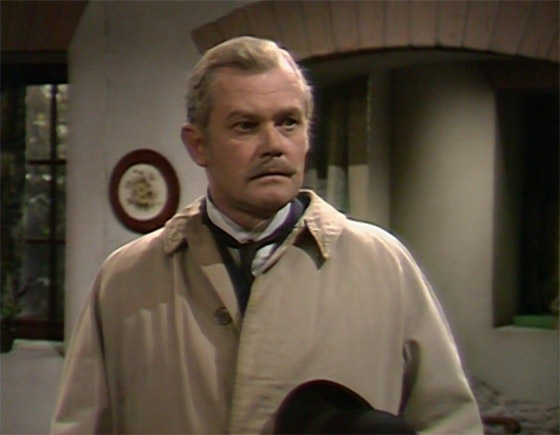 Still, this is “Hound of the Baskervilles,” and so you don’t get a lot of Sherlock Holmes. It’s Watson’s show, and Watson here is Nigel Stock (not to be confused with Nigel Bruce, the most famous Watson of all, from the long-running film series with Basil Rathbone). For an extraordinary time I was gnawing at my own fist trying to remember how I knew Nigel Stock, until I realized that he was in The Prisoner, subtituting for Patrick McGoohan, thanks to body-swapping, in the episode “Do Not Forsake Me Oh My Darling.” It’s the one episode I really, really wish hadn’t been made, since every minute of that program seems to violate the premise and themes of the series. But never mind. After a while I managed to stop holding that against Stock’s performance as Watson – which would really be unfair, don’t you think? – and came to the conclusion that he’s perfectly fine in the role. Crucially, he doesn’t portray Watson as a bumbling fool, which the character never was in Doyle’s hands. Ultimately, I prefer André Morrell from the Terence Fisher version, but I could believe Stock as Watson, and that’s what matters.
Still, this is “Hound of the Baskervilles,” and so you don’t get a lot of Sherlock Holmes. It’s Watson’s show, and Watson here is Nigel Stock (not to be confused with Nigel Bruce, the most famous Watson of all, from the long-running film series with Basil Rathbone). For an extraordinary time I was gnawing at my own fist trying to remember how I knew Nigel Stock, until I realized that he was in The Prisoner, subtituting for Patrick McGoohan, thanks to body-swapping, in the episode “Do Not Forsake Me Oh My Darling.” It’s the one episode I really, really wish hadn’t been made, since every minute of that program seems to violate the premise and themes of the series. But never mind. After a while I managed to stop holding that against Stock’s performance as Watson – which would really be unfair, don’t you think? – and came to the conclusion that he’s perfectly fine in the role. Crucially, he doesn’t portray Watson as a bumbling fool, which the character never was in Doyle’s hands. Ultimately, I prefer André Morrell from the Terence Fisher version, but I could believe Stock as Watson, and that’s what matters.
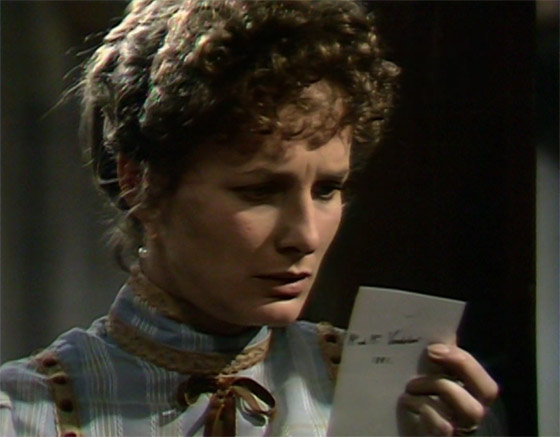 Neil Gaiman once said, when describing why his Neverwhere BBC series looked the way it did, “The BBC, at least at the time, had kind of a sausage mentality. It didn’t really matter what you put in at one end, you got Doctor Who out.” He was referring to the old Doctor Who of course, not the highly-polished new series (for which he’s written); but that sausage-making syndrome is exactly what you get with Sherlock Holmes. The outdoor scenes are grainy and somewhat clumsily handled; the indoor scenes are on obvious sets, with on-the-fly directing, no retakes, and sometimes muffled sound. It might as well be live television from the early 50’s. The Hound itself looks like…a cuddly dog who knows how to roll over and play dead when the director asks. And when I said these two programs were faithful to Doyle’s tale, I should have said: There is a lot of dialogue. Hammer’s version, for all its changes, made the story cinematic. This rendering is for armchair viewing only, with long stretches in which the characters simply recite facts at one another, and go over the clues or drop them. It’s charming. With nothing stylistically notable, you lower your expectations fast as the first episode begins, and then take pleasures from the story itself, with a smile at the occasional improvised flourish by an actor. Sir Arthur Conan Doyle comes to the forefront; and the story is a classic. Despite the klutziness, there’s plenty here to enjoy, in other words.
Neil Gaiman once said, when describing why his Neverwhere BBC series looked the way it did, “The BBC, at least at the time, had kind of a sausage mentality. It didn’t really matter what you put in at one end, you got Doctor Who out.” He was referring to the old Doctor Who of course, not the highly-polished new series (for which he’s written); but that sausage-making syndrome is exactly what you get with Sherlock Holmes. The outdoor scenes are grainy and somewhat clumsily handled; the indoor scenes are on obvious sets, with on-the-fly directing, no retakes, and sometimes muffled sound. It might as well be live television from the early 50’s. The Hound itself looks like…a cuddly dog who knows how to roll over and play dead when the director asks. And when I said these two programs were faithful to Doyle’s tale, I should have said: There is a lot of dialogue. Hammer’s version, for all its changes, made the story cinematic. This rendering is for armchair viewing only, with long stretches in which the characters simply recite facts at one another, and go over the clues or drop them. It’s charming. With nothing stylistically notable, you lower your expectations fast as the first episode begins, and then take pleasures from the story itself, with a smile at the occasional improvised flourish by an actor. Sir Arthur Conan Doyle comes to the forefront; and the story is a classic. Despite the klutziness, there’s plenty here to enjoy, in other words.
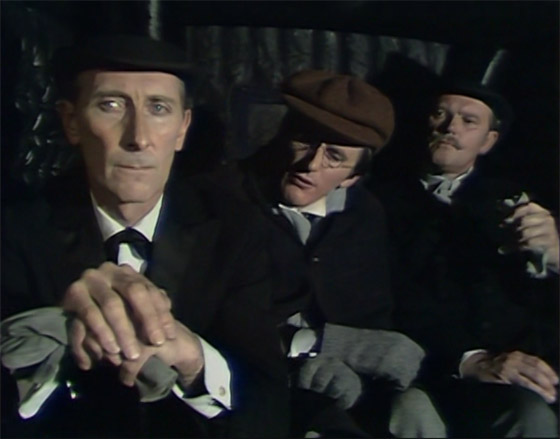 As for Peter Cushing, he had a few more years to give to the likes of Hammer and Amicus before he began a gradual withdrawal from acting following his wife’s death in the early 70’s. He’s still best known for his role in Star Wars and as Hammer’s Dr. Frankenstein, but I’d always seen the one-off 1958 Hound of the Baskervilles as a missed opportunity – what should have been the launch of a Hammer Holmes series. The A&E set, in compiling the surviving BBC episodes, is most valuable in allowing everyone a prolonged look at Cushing as Holmes – one of the best Holmes there ever was.
As for Peter Cushing, he had a few more years to give to the likes of Hammer and Amicus before he began a gradual withdrawal from acting following his wife’s death in the early 70’s. He’s still best known for his role in Star Wars and as Hammer’s Dr. Frankenstein, but I’d always seen the one-off 1958 Hound of the Baskervilles as a missed opportunity – what should have been the launch of a Hammer Holmes series. The A&E set, in compiling the surviving BBC episodes, is most valuable in allowing everyone a prolonged look at Cushing as Holmes – one of the best Holmes there ever was.









